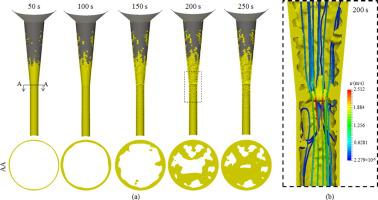当前位置:
X-MOL 学术
›
Powder Technol.
›
论文详情
Our official English website, www.x-mol.net, welcomes your feedback! (Note: you will need to create a separate account there.)
A transient model for nozzle clogging – Part II: Validation and verification
Powder Technology ( IF 5.2 ) Pub Date : 2017-11-01 , DOI: 10.1016/j.powtec.2017.11.035 H. Barati , M. Wu , A. Kharicha , A. Ludwig
Powder Technology ( IF 5.2 ) Pub Date : 2017-11-01 , DOI: 10.1016/j.powtec.2017.11.035 H. Barati , M. Wu , A. Kharicha , A. Ludwig

|
Abstract Part I of this two-part work discusses a transient two-way coupling model for clogging of nozzle (fluid passage) due to deposition of suspended particles on the nozzle wall. The purpose of Part II is to validate and verify the model. To this end, the current model simulates a laboratory experiment, designed to study the clogging of a submerged entry nozzle (SEN) during steel continuous casting. It demonstrates that the model can reproduce the experiment satisfactorily: the numerically-calculated clogged section of the nozzle is qualitatively comparable with typically “as-clogged” sections in laboratory experiments; the calculated mass flow rate through the nozzle during clogging process as function of time is also in agreement with the experimentally-monitored result. The simulation-experiment agreement depends on parameters, e.g. mesh size, Lagrangian time scale, correction factor in interpolation of clog permeability, and porosity in the clog materials, which act as inputs for the numerical model. Uncertainties for choosing such parameters, model capabilities/limitations due to model assumptions have been studied and discussed in this paper. In this regard, further model refinements are suggested. The modeling results provide new knowledge about clogging behavior. (1) Clogging is a transient process, and it includes the initial coverage of the nozzle wall with deposited particles, the evolution of a bulged clog front, and then the development of branched structure. This transient growth of clog interacts with the flow. (2) Clogging is a stochastic and self-accelerating process.
中文翻译:

喷嘴堵塞的瞬态模型——第二部分:验证和验证
摘要 该两部分工作的第一部分讨论了由于悬浮颗粒沉积在喷嘴壁上而导致喷嘴(流体通道)堵塞的瞬态双向耦合模型。第二部分的目的是验证和验证模型。为此,当前模型模拟了一项实验室实验,旨在研究钢连铸过程中浸入式水口 (SEN) 的堵塞情况。它表明该模型可以令人满意地再现实验:喷嘴的数值计算的堵塞截面与实验室实验中典型的“堵塞”截面在质量上具有可比性;在堵塞过程中作为时间函数计算的通过喷嘴的质量流量也与实验监测结果一致。模拟实验协议取决于参数,例如 网格尺寸、拉格朗日时间尺度、堵塞渗透率插值的校正因子以及堵塞材料中的孔隙率,它们作为数值模型的输入。本文已经研究和讨论了选择此类参数的不确定性、由于模型假设而导致的模型能力/限制。在这方面,建议进一步改进模型。建模结果提供了有关堵塞行为的新知识。(1) 堵塞是一个瞬态过程,它包括沉积颗粒最初覆盖喷嘴壁,膨胀堵塞前沿的演变,然后分支结构的发展。堵塞物的这种瞬时增长与流动相互作用。(2) 堵塞是一个随机的、自加速的过程。和堵塞材料中的孔隙率,作为数值模型的输入。本文已经研究和讨论了选择此类参数的不确定性、由于模型假设而导致的模型能力/限制。在这方面,建议进一步改进模型。建模结果提供了有关堵塞行为的新知识。(1) 堵塞是一个瞬态过程,它包括沉积颗粒最初覆盖喷嘴壁,膨胀堵塞前沿的演变,然后分支结构的发展。堵塞物的这种瞬时增长与流动相互作用。(2) 堵塞是一个随机的、自加速的过程。和堵塞材料中的孔隙率,作为数值模型的输入。本文已经研究和讨论了选择此类参数的不确定性、由于模型假设而导致的模型能力/限制。在这方面,建议进一步改进模型。建模结果提供了有关堵塞行为的新知识。(1) 堵塞是一个瞬态过程,它包括沉积颗粒最初覆盖喷嘴壁,膨胀堵塞前沿的演变,然后分支结构的发展。堵塞物的这种瞬时增长与流动相互作用。(2) 堵塞是一个随机的、自加速的过程。本文已经研究和讨论了由于模型假设而导致的模型能力/限制。在这方面,建议进一步改进模型。建模结果提供了有关堵塞行为的新知识。(1) 堵塞是一个瞬态过程,它包括沉积颗粒最初覆盖喷嘴壁,膨胀堵塞前沿的演变,然后分支结构的发展。堵塞物的这种瞬时增长与流动相互作用。(2) 堵塞是一个随机的、自加速的过程。本文已经研究和讨论了由于模型假设而导致的模型能力/限制。在这方面,建议进一步改进模型。建模结果提供了有关堵塞行为的新知识。(1) 堵塞是一个瞬态过程,它包括沉积颗粒最初覆盖喷嘴壁,膨胀堵塞前沿的演变,然后分支结构的发展。堵塞物的这种瞬时增长与流动相互作用。(2) 堵塞是一个随机的、自加速的过程。然后是分支结构的发展。堵塞物的这种瞬时增长与流动相互作用。(2) 堵塞是一个随机的、自加速的过程。然后是分支结构的发展。堵塞物的这种瞬时增长与流动相互作用。(2) 堵塞是一个随机的、自加速的过程。
更新日期:2017-11-01
中文翻译:

喷嘴堵塞的瞬态模型——第二部分:验证和验证
摘要 该两部分工作的第一部分讨论了由于悬浮颗粒沉积在喷嘴壁上而导致喷嘴(流体通道)堵塞的瞬态双向耦合模型。第二部分的目的是验证和验证模型。为此,当前模型模拟了一项实验室实验,旨在研究钢连铸过程中浸入式水口 (SEN) 的堵塞情况。它表明该模型可以令人满意地再现实验:喷嘴的数值计算的堵塞截面与实验室实验中典型的“堵塞”截面在质量上具有可比性;在堵塞过程中作为时间函数计算的通过喷嘴的质量流量也与实验监测结果一致。模拟实验协议取决于参数,例如 网格尺寸、拉格朗日时间尺度、堵塞渗透率插值的校正因子以及堵塞材料中的孔隙率,它们作为数值模型的输入。本文已经研究和讨论了选择此类参数的不确定性、由于模型假设而导致的模型能力/限制。在这方面,建议进一步改进模型。建模结果提供了有关堵塞行为的新知识。(1) 堵塞是一个瞬态过程,它包括沉积颗粒最初覆盖喷嘴壁,膨胀堵塞前沿的演变,然后分支结构的发展。堵塞物的这种瞬时增长与流动相互作用。(2) 堵塞是一个随机的、自加速的过程。和堵塞材料中的孔隙率,作为数值模型的输入。本文已经研究和讨论了选择此类参数的不确定性、由于模型假设而导致的模型能力/限制。在这方面,建议进一步改进模型。建模结果提供了有关堵塞行为的新知识。(1) 堵塞是一个瞬态过程,它包括沉积颗粒最初覆盖喷嘴壁,膨胀堵塞前沿的演变,然后分支结构的发展。堵塞物的这种瞬时增长与流动相互作用。(2) 堵塞是一个随机的、自加速的过程。和堵塞材料中的孔隙率,作为数值模型的输入。本文已经研究和讨论了选择此类参数的不确定性、由于模型假设而导致的模型能力/限制。在这方面,建议进一步改进模型。建模结果提供了有关堵塞行为的新知识。(1) 堵塞是一个瞬态过程,它包括沉积颗粒最初覆盖喷嘴壁,膨胀堵塞前沿的演变,然后分支结构的发展。堵塞物的这种瞬时增长与流动相互作用。(2) 堵塞是一个随机的、自加速的过程。本文已经研究和讨论了由于模型假设而导致的模型能力/限制。在这方面,建议进一步改进模型。建模结果提供了有关堵塞行为的新知识。(1) 堵塞是一个瞬态过程,它包括沉积颗粒最初覆盖喷嘴壁,膨胀堵塞前沿的演变,然后分支结构的发展。堵塞物的这种瞬时增长与流动相互作用。(2) 堵塞是一个随机的、自加速的过程。本文已经研究和讨论了由于模型假设而导致的模型能力/限制。在这方面,建议进一步改进模型。建模结果提供了有关堵塞行为的新知识。(1) 堵塞是一个瞬态过程,它包括沉积颗粒最初覆盖喷嘴壁,膨胀堵塞前沿的演变,然后分支结构的发展。堵塞物的这种瞬时增长与流动相互作用。(2) 堵塞是一个随机的、自加速的过程。然后是分支结构的发展。堵塞物的这种瞬时增长与流动相互作用。(2) 堵塞是一个随机的、自加速的过程。然后是分支结构的发展。堵塞物的这种瞬时增长与流动相互作用。(2) 堵塞是一个随机的、自加速的过程。


























 京公网安备 11010802027423号
京公网安备 11010802027423号